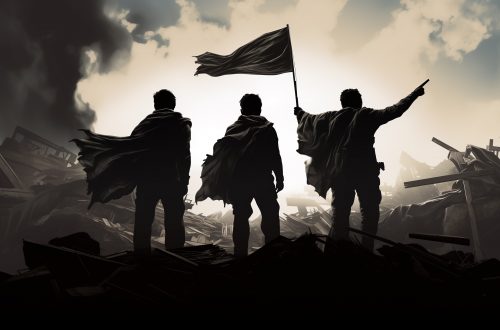This is a guest post by Michelle Sieff of Z Word
Two prominent Israeli writers have published thought-provoking articles on the unfolding conflict in Gaza: the journalist Yossi Klein Halevi in The New Republic and historian Benny Morris in the New York Times.
Morris’ article is stirring and powerful. He describes a portentous shift in the collective psyche of Israel, a sense, as he puts it, “that the walls – and history – are closing in on their 60-year-old state, much as they felt in early June 1967, just before Israel launched the Six-Day War and destroyed the Egyptian, Jordanian, and Syrian armies in Sinai, the West Bank and the Golan Heights.”
Morris identifies two main causes of this shift: the widespread rejection of Israel’s right to exist in the Arab and wider Islamic world and the gradual undermining of Israel’s legitimacy in Western public opinion. As Morris explains, in the Muslim world, Israel’s right to exist is threatened by a trio of unconventional – and frightening – political movements: to the east, Iran, a country currently led by a president who regularly threatens to destroy Israel and the Jews; to the north, the Iranian-proxy Hezbollah, based in Lebanon, which also vows to destroy Israel; and to the south, Hamas, which now controls Gaza and whose charter promises to destroy Israel and bring all of Palestine under Islamic rule.
Though Morris does not lay this out, Shiite or Sunni, state or non-state, these political actors share one thing in common: they all embrace a toxic ideology that is totalitarian – an example of what the philosopher Hannah Arendt called “radical evil.” In their theory of history, they all require the elimination of one group of people from this earth: the Jews, many of whom since 1948 have resided in the state of Israel.
Halevi’s article really begins where Morris leaves off, for he weighs the possible scenarios and consequences of Israel’s response to these horrifying threats. He says there are three possible scenarios for how the Gaza operation will evolve: (1) a limited attack whose goal is not to overthrow the Hamas regime but instead to attain better terms for the next ceasefire, such as supervision of the tunnels linking Gaza with Egypt through which Hamas smuggled missiles; (2) the overthrow of Hamas; and (3) a combination of the two, where a limited operation mutates into an all-out war against Hamas. He predicts that the third is the most likely scenario.
He foresees many terrible consequences as a result of the Gaza operation: a rise in suicide bombings; more missile attacks from Hamas and, possibly, Hezbollah, if it decides to open a second front; and distraction from the Iranian nuclear threat.
He also understands what all too often the Israeli government has ignored: wars are also fought on the battleground of public opinion, and Israel cannot afford to lose this battle, as it did in Lebanon. Because Israel consistently loses these public relations wars, the belief in Israel’s legitimacy is declining among opinion shapers in the West, as Morris observes. To win this battle requires responding to the most frequent charge against Israel: that it uses “disproportionate force,” thus perpetrating “war crimes.”
Halevi answers this charge by arguing that, by not responding to Hamas’ incessant rocket attacks against Israel, “it is the government’s shameful non-response to attacks that was disproportionate.”
Because it is so critical to win this debate, I’ll just put forth my own response, in the Socratic method of a question: What constitutes a proportional response when one party has as its strategic objective the complete destruction of the Jewish state, the goal of genocide? Any reasonable person who takes into account Hamas’ objective can only conclude that Israel’s response – where its military assiduously attempts to target terrorists and avoid civilian casualties – is not “disproportionate.”
But as the body count rises, and it will, we must keep in mind the larger question that I have posed. We cannot possible assess the morality of Israel’s actions without understanding the meaning of Israel’s battle in Gaza. And, on this point, Morris’ evocation of 1967 is significant. He suggests that Israel – which just celebrated its 60th anniversary – is at a defining moment in its history.
It is Halevi who really explains why the outcome of the Gaza operation is so essential to Israel’s future. He argues that the future of the two-state solution hangs in the balance. Gaza was a crucial test of the land for peace theory, the fulcrum of the two-state solution. But when Israel withdrew, Hamas continued to fire rockets. If Israel is not allowed to defend itself now, it certainly will never withdraw from the West Bank.
In my mind, Halevi’s interpretation of the meaning of the battle underway in Gaza is more compelling. In his conclusion, he writes: “Most of all, what’s required is patience, and the realization among Israelis and our friends abroad that this battle is part of the larger war against jihadism that shifts from one part of the world to the other, and whose outcome will define our generation.”
Halevi suggests that the future of the civilized world – and not just Israel’s future – is at stake in Gaza. Gaza, Mumbai, Afghanistan, Lebanon, Iraq, Somalia, Pakistan, Iran. These are all fronts in what is, fundamentally, one long war against variations of radical Islamism, a threat to liberal civilization that resembles the Fascist and Stalinist threats of the mid-twentieth century. Liberal democracies are sometimes faced with threats that can no longer be ignored. Halevi and Morris tell us why, for Israel – and for the rest of the civilized world – that moment is now.


